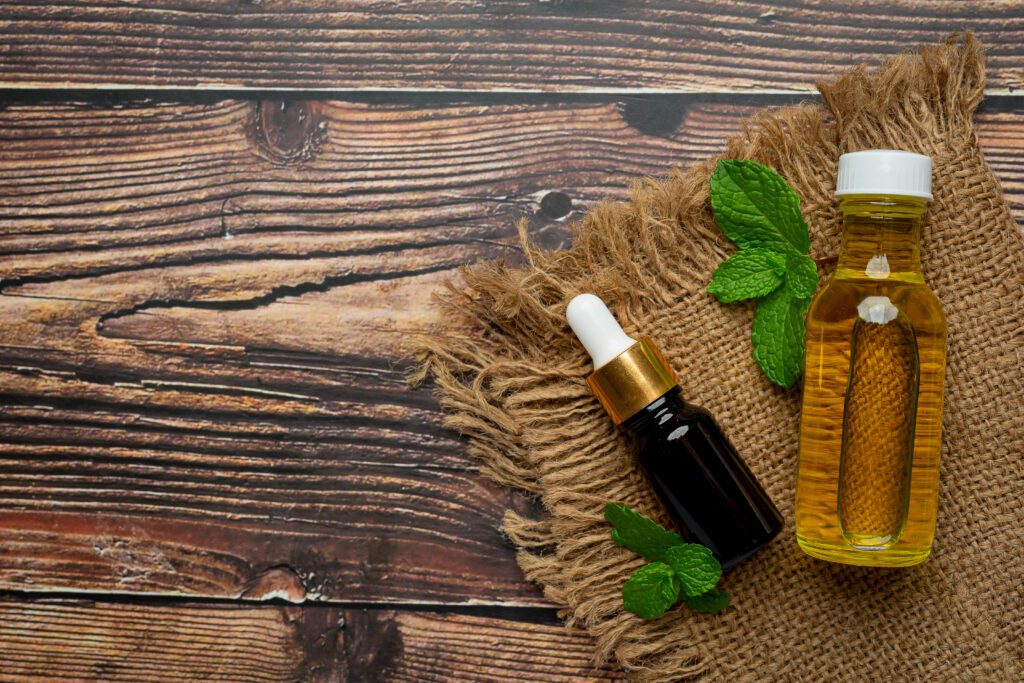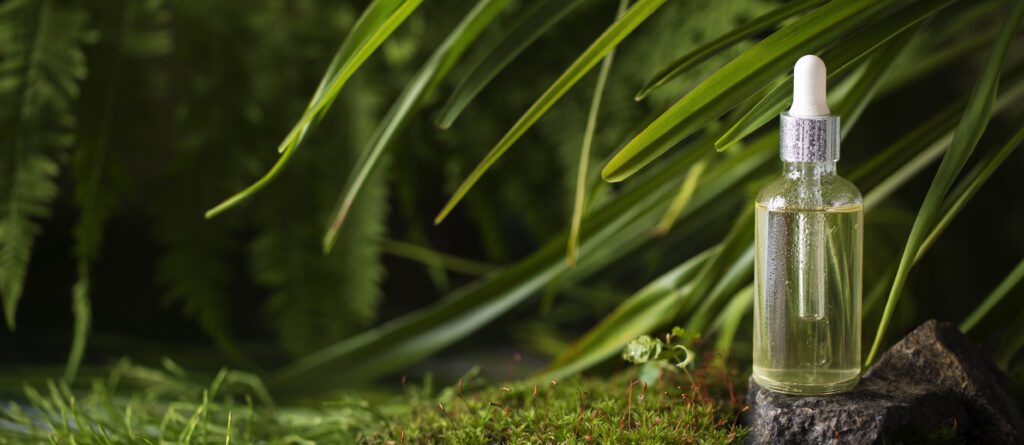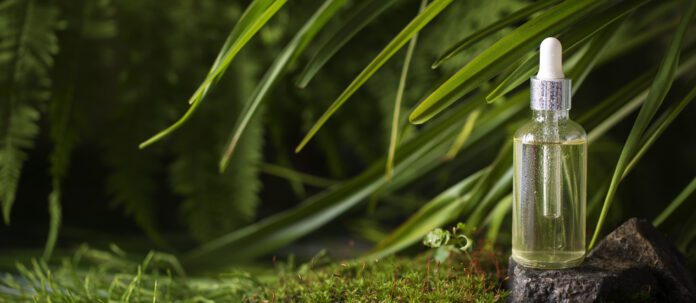Tea Tree Oil for Skin Whitening. Melaleuca alternifolia trees from Australia produce tea tree oil that has gained immense popularity as a skincare product. Due to its antimicrobial, antibacterial, and anti-inflammatory properties, people widely use tea tree oil for acne, blemishes, and various skin problems; a less discussed but increasingly popular use is for lightening skin tone. Let’s examine some potential applications and address frequently asked questions (FAQs).

Tea tree oil benefits skin whitening.
Reduce hyperpigmentation by 1. Reducing pigment absorption and 2. Minimizing pigment deposition.
Excessive melanin production can cause hyperpigmentation, which can lead to dark spots, an uneven complexion, and redness and discoloration. Tea tree oil contains anti-inflammatory properties that help reduce redness and discoloration to even out your skin tone and create an even skin tone.
2. Fight Acne Scars
Acne scars can leave noticeable dark marks on the skin. Tea tree oil’s antibacterial qualities help prevent breakouts, while its skin-repairing abilities help fade acne scars over time.
3. Brightening Dull Skin
Tea tree oil plays an essential role in cell renewal and rejuvenation, helping to rejuvenate dull skin and make it appear healthier and brighter with regular usage. Regular application can bring rejuvenated, dull skin back to life for healthier-looking results.
4. Soothe Skin Irritations
Skin affected by irritation or inflammation typically appears dark or red. Tea tree oil helps ease redness and irritation and makes the skin’s tone appear more even.
5. Tea Tree Oil Exfoliates Naturally
When mixed with carrier oils or scrubs, tea tree oil acts as an exfoliator, providing natural exfoliation by removing dead skin cells that cause uneven skin tone.
How to Use Tea Tree Oil for Skin Whitening
Tea tree oil, while powerful and effective, requires appropriate application to prevent irritation and negative outcomes. Here are a few strategies for including tea tree oil in your skincare regime:
1. Dilute with carrier oils (e.g., olive or canola oil).
Avoid applying tea tree oil directly to the skin due to its high concentration. Instead, mix it with carrier oils like almond, coconut, or jojoba oil before applying it directly onto affected areas for maximum efficacy.
2. Add to Your Moisturizer
Introduce tea tree oil into your lotion or moisturizer of choice to achieve uniform application, as well as to boost its lightening effects over time. This approach ensures more uniform results when lightening skin over time.
3. Tea Tree Oil Face Mask
Craft a homemade makeup mask by mixing tea tree oil with natural ingredients such as yogurt, honey, or aloe vera gel. Apply this face mask for 15-20 minutes before rinsing off with warm water to finish up.
4. Spot Treatment
To address areas with darkening or blemishes, dilute tea tree oil with water or an oil carrier and apply directly to the affected areas using cotton swabs once daily. For best results, repeat your application after each bath session.
5. Make use of a facial scrub.
Combine some drops of tea tree oil with some sugar from coffee grounds or sugar and apply this mixture directly onto your skin to rid yourself of dead cells and create an even complexion.


Precautions and tips for utilizing tea tree oil
Apply a patch test: Always perform a patch test with tea tree oil prior to applying it directly on the face in order to make sure there are no allergic reactions.
Diluting tea tree oil: Before use is of the utmost importance; otherwise it could result in skin irritation.
Avoid Overuse: Limit application to no more than once or twice daily to avoid irritation and dryness.
Use sunscreen when taking tea tree oil: The use of tea tree oil may increase sensitivity to sunlight, so always apply a layer of sunscreen during the daytime.
Consult a Dermatologist: Before using tea tree oil on sensitive skin or having existing skin conditions, consult with a dermatologist first.
Frequently Asked Questions (FAQs):
Q1: What is tea tree oil, and can it help permanently whiten my skin
People have long touted tea tree oil’s ability to lighten skin tone.
Tea tree oil won’t alter the hue of your skin permanently but can help diminish spots, blemishes, and dark spots over time, providing an even and radiant complexion.
Q2: What are the results of using tea tree oil for skin whitening?
Results can differ depending on the skin type and degree of problem; visible improvements to its appearance typically appear after about 4-6 weeks of continued application.
Q3: Is tea tree oil suitable for all skin types?
Yes. Tea tree oil can be beneficial in treating all kinds of skin conditions.
Tea tree oil is generally safe for all skin types; however, those with sensitive skin may experience irritation. Always dilute using a carrier oil first and conduct an initial patch test prior to full application.
Q4: Are there any adverse side effects associated with using oils from tea trees?
Some individuals may experience dryness, redness, or irritation upon using tea tree oil in its pure form. To avoid adverse reactions from this solution, always follow the directions for use to ensure safety.
Q5: What can tea tree oil do to help with dark circles around my eyes?
Studies have shown that tea tree oil effectively reduces dark circles and puffiness caused by inflammation. When using this treatment around your eyes, however, take caution by diluting it first before applying it directly to them and avoiding direct contact.
Q6: What is the recommended frequency for applying tea tree oil for skin whitening purposes?
Only apply tea tree oil for brief periods of time twice daily to provide relief, as overexposure could cause irritation and dryness.
Q7: Do I need to mix tea tree oil and other ingredients together for skin lightening purposes?
You can combine tea tree oil with other natural ingredients like citrus juice, aloe vera gel, or turmeric to enhance its skin-lightening effects. Make sure to dilute it properly to avoid any unwanted side effects.
Q8: Will tea tree oil help with my old marks and acne scars?
Tea tree oil has the power to help fade scars over time by stimulating skin repair and diminishing pigmentation, so applying it consistently is key for maximum benefit.
Q9: Is tea tree oil safe to use over an extended period?
Tea tree oil can be safely used long-term when applied as directed and in a diluted form, provided it is applied correctly and monitored closely for skin reactions; in case of irritation, discontinue use immediately.
Q10: Is it safe to use tea tree oil during pregnancy?
Pregnant women generally believe it to be safe when taking Vitamin K during gestation; however, it’s best to consult their physician first in order to ensure there are no risks for either themselves or their baby.


Conclusion
Tea tree oil offers many natural solutions for an even, brighter skin tone, from treating hyperpigmentation and blemishes to rejuvenating dull skin and its anti-aging benefits. For maximum efficacy and success, as with all skincare products, one must observe proper usage and safety precautions.
Introduce tea tree oil into your daily skincare regimen and experience its transformative powers on your complexion. Through consistent use and dedication, you will experience radiant and even-toned skin!

